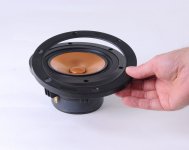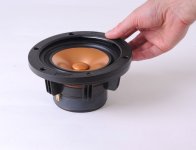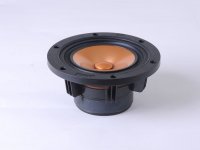Hi Guys,
Your opinions are needed. Alpair generation 2 drivers get a new cover added to the front of the frames. Alpair 7 and Alpair 12 were the first drivers to receive the trims. Not a problem as these are all-new designs. However, for Alpair's 5, 6 and 10, these drivers are already circulating so now we have a conundrum. Adding the cover increases the O/D of the frames. It won't be a "straight-in" replacement for those DIYer's wishing to upgrade from Generation 1 to Gen. 2 Alpairs for cabs that have recessed driver mounts.
For example: The Alpair 10, adding the cover takes the frame O/D from 160-mm to 165-mm.
Do I:
1 - Glue the covers on at the factory (like Alpair 7 and 12)
2 - Leave the cover loose for folks to choose to use or discard
3 - Offer both factory glued and loose choices.
Please vote or voice you opinions. I'm trying this as a poll, hope I've made the right menu selection (never done this before).
Cheers
Mark.
Your opinions are needed. Alpair generation 2 drivers get a new cover added to the front of the frames. Alpair 7 and Alpair 12 were the first drivers to receive the trims. Not a problem as these are all-new designs. However, for Alpair's 5, 6 and 10, these drivers are already circulating so now we have a conundrum. Adding the cover increases the O/D of the frames. It won't be a "straight-in" replacement for those DIYer's wishing to upgrade from Generation 1 to Gen. 2 Alpairs for cabs that have recessed driver mounts.
For example: The Alpair 10, adding the cover takes the frame O/D from 160-mm to 165-mm.
Do I:
1 - Glue the covers on at the factory (like Alpair 7 and 12)
2 - Leave the cover loose for folks to choose to use or discard
3 - Offer both factory glued and loose choices.
Please vote or voice you opinions. I'm trying this as a poll, hope I've made the right menu selection (never done this before).
Cheers
Mark.
Attachments
Last edited:
This may be a stupid question, but what is it for? The driver looks already good without it.
I would like to see a nice nameplate, an aluminium one in the colour of the cone. Alpair 12 is going to be my summer holiday project.
The covers when glued using A/B (epoxy) adhesives, increase the front frame rigidity. The total mass of the frame is increased, adding to the damping characteristics of the design. They also hide the glue trap between the edge of the front suspension and its frame mounting location. The logo and nameplate is moulded into the cover.
An alu cover isn't not a good idea given its propensity to adversely resonate. Matching cover alu to cone alu would be very challenging given that the alloy grades won't match.
Enjoy Alpair 12 this summer!
Mark.
Last edited:
My gut feeling says that option 3 would result in dealers having to carry extra stock on hand, resulting in more work for everyone and as a result potentially higher pricing, plus more confusion for customers.
From the viewpoint of a builder/owner, #1 is scary to me. These are high end drivers that tend to be put into cabinets without much protection in the way of grills, and in cabinets with a lot of work put into them. These are "keep for life" type of speakers, and if the frame geometry were to suddenly change, it would mean if a driver was to be damaged somehow, there'd be no way to replace it.
All things being equal, I prefer a choice to no-choice. so #3 would be my natural option, but in this case I gotta go for #2 because the ultimate choice is having the flexibility to do it myself.
From the viewpoint of a builder/owner, #1 is scary to me. These are high end drivers that tend to be put into cabinets without much protection in the way of grills, and in cabinets with a lot of work put into them. These are "keep for life" type of speakers, and if the frame geometry were to suddenly change, it would mean if a driver was to be damaged somehow, there'd be no way to replace it.
All things being equal, I prefer a choice to no-choice. so #3 would be my natural option, but in this case I gotta go for #2 because the ultimate choice is having the flexibility to do it myself.
That said, the frames look great, and another reason I'd like to have the choice of the driver with no frame is that I'm currently planning an A10 build where I'm going to be making a very similar cover myself that fits over the driver in a similar manner, but is made from wood.
Also, though I know it's good for you to have your logo on things so people recognize your work, as a designer I like a really clean design and prefer the unmarked frame. It's subtle and not a huge deal, but it definitely affects the way I see the drivers. Furthermore, the lack of logo gives added mounting flexibility, as you don't have to mount it at a specific angle!
Also, though I know it's good for you to have your logo on things so people recognize your work, as a designer I like a really clean design and prefer the unmarked frame. It's subtle and not a huge deal, but it definitely affects the way I see the drivers. Furthermore, the lack of logo gives added mounting flexibility, as you don't have to mount it at a specific angle!
Last edited:
In my opinion:
I think it looks better without the cover and can`t see any advantages to it at all.
It increases tweeter to mid distance slightly. If you flush mount it, it will be slightly more behind the tweeter in the vertical plane(wrong direction).
Yes, the differences is very small, but still unnessesary IMO.
When mounted on a rigid baffle the small added rigidity from the cover won`t make any significant difference.
Does it also add to the cost?
Regards,
Peter
I think it looks better without the cover and can`t see any advantages to it at all.
It increases tweeter to mid distance slightly. If you flush mount it, it will be slightly more behind the tweeter in the vertical plane(wrong direction).
Yes, the differences is very small, but still unnessesary IMO.
When mounted on a rigid baffle the small added rigidity from the cover won`t make any significant difference.
Does it also add to the cost?
Regards,
Peter
Seeing the pictures with and without, the extra ring leaves a circular ridge all way round the driver. Without it is almost flush. Flush is good. Leave it as an option.
Extra ridgidity, maintaining a flat defration free profile, and a flat mounting surface could be achieved with a ring that plugs into the cavities on the back of the bezel.
That sounds way more expensive to me thou.
dave
Extra ridgidity, maintaining a flat defration free profile, and a flat mounting surface could be achieved with a ring that plugs into the cavities on the back of the bezel.
That sounds way more expensive to me thou.
dave
I voted to leave them loose.
I wouldn't want them anyways as I like to mount drivers flush with the baffle and those things stick out.
well, just make the baffle a little thicker and the outer bezel opening a bit wider?
I must say that the fact that Mark even polls for our opinion speaks volumes
I'm with Dave on this one, i like to see as flat a surface as possible at the driver edge to reduce diffraction effects. You also tend to make drivers with rather a high bandwidth so i'd be inclined even more to leave it as an option for the buyer.Seeing the pictures with and without, the extra ring leaves a circular ridge all way round the driver. Without it is almost flush. Flush is good. Leave it as an option.
dave
On a slightly different note, why not make the "cover" fit on the rear of the frame if people want to stiffen it up
That's one very nice looking unit Mark, as has been mentioned & i agree, it looks better & should sound better without the front cover.
My vote is optional
Bests, another Mark
Last edited:
Hi Mark - very nice of you to ask for input and appreciated. 
All things considered I'm going with option #2.
My QC gut tells me to keep it simple - which means fewer parts and fewer chances for customers to mess things up. In this case your customers are people that enjoy playing around with things and thus enjoy more options to play around with.
Of course we could really get things going crazy if you wanted suggestions about how we put some patterns onto the outer ring to act as a diffuser.
if you wanted suggestions about how we put some patterns onto the outer ring to act as a diffuser. 
All things considered I'm going with option #2.
My QC gut tells me to keep it simple - which means fewer parts and fewer chances for customers to mess things up. In this case your customers are people that enjoy playing around with things and thus enjoy more options to play around with.
Of course we could really get things going crazy
 if you wanted suggestions about how we put some patterns onto the outer ring to act as a diffuser.
if you wanted suggestions about how we put some patterns onto the outer ring to act as a diffuser. 
- Status
- This old topic is closed. If you want to reopen this topic, contact a moderator using the "Report Post" button.
- Home
- Loudspeakers
- Full Range
- Alpair-10: to cover or not to cover, that is the question


